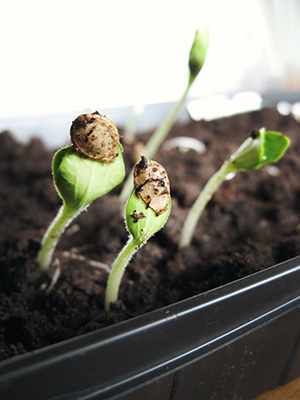Advanced Seed Starting

Most of the time, we think of seed starting as nursing seedlings in greenhouse trays. However, some seeds need a bit more effort than simply planting and watering for the best germination rate. Read on to learn about three advanced seed treatment methods to add to your trove of gardening knowledge.
Scarification
Some seeds have a hard seed coat that needs to be weakened or removed before the seed will sprout. This can be done chemically, mechanically, or with hot water. A chemical treatment would involve using acid to break down and weaken the coat, although this is typically not the easiest method for home gardeners. Hot water that is between 170- and 210-degrees Fahrenheit can also be used to soften the coat. But most gardeners opt to remove the seed coat mechanically using a file, sand paper, a hammer, etc. Examples of plants that benefit from scarification include camellias, redbuds, peaches, and members of the Zamia genus.
Imbibition
Imbibition refers to the process of rehydrating seeds. The seeds we receive are typically dry, which is perfect for storage. However, the seed must become hydrated for germination to begin. Imbibition often happens when you water your seeds after direct seeding or starting transplants. Although, sometimes seeds benefit from being manually imbibed before being planted or stratified (see below). This involves soaking seeds in water, for up to an hour for small seeds to several hours or even overnight for larger seeds. Examples of seeds that benefit from imbibition include legumes like garbanzo or black beans.

Stratification
Other seeds require chilling or heat before they will end dormancy and sprout; this needed change in temperature is called “stratification.” For cold, sometimes this is naturally accomplished by simply planting them outdoors in the fall (assuming their needs will be met by the weather). Otherwise, you can complete this process artificially using a refrigerator. Imbibed seeds are layered in a moist medium, such as sand, vermiculite, sphagnum, or peat and then placed in a refrigerator for as long as they need to break dormancy. You can also simply place the seeds in a moist paper towel within a plastic bag before refrigerating. Typically, this takes one to four months. Examples of plants that need cold stratification are dogwood, hollies, and magnolias.
Other plants require heat to sprout seeds, such as palms. You can read about palm seeds in the Ask IFAS publication, “Palm Seed Germination.” You can also use heating mats to germinate the seeds of warm weather crops (such as tomatoes and peppers) early. Then you don’t have to worry about whether the soil in your garden is warm enough for your seeds yet.
Some plants may even need a combination of these methods. Cold-warm-cold stratifications, or scarification followed by stratification are examples. Be sure to research each plant you’re hoping to start from seed to ensure you follow the correct process. A good rule of thumb University of Florida researchers use for native species, is to consider what happens in nature naturally. If seeds are shed from the plant in the fall and then remain in the moist leaf litter over winter prior to germinating in the spring, this could be a clue. Similarly, if seeds are surrounded by a fleshy outer layer that attracts birds, and are then noticed to germinate much farther away, this could be another clue. Other seeds or more versatile species can germinate soon after they are collected from the plant with no pretreatment necessary.
If you have any questions as you attempt these advanced seed starting methods, don’t hesitate to reach out to the experts at your county Extension office.
